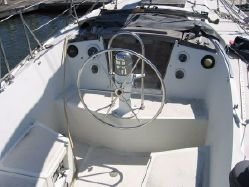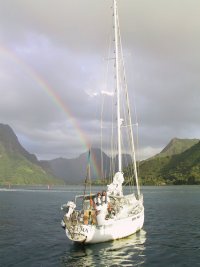I'm new here but I've been lurking for a few weeks already. I've already found a lot of valuable information and want to say thank you to everyone that puts up pictures and how-to's.
My last sailboat was a MacGregor 19 powersailer and right now I'm feeling a tad overwhelmed but still managing to look forward to the work ahead.
I recently acquired an E39 flush deck. Hull #16.
I'm pretty sure it's essentially been abandoned for years with someone occassionally picking up a grinder to cut another notch in her. I got her for about a quarter of her scrap value so I'm doing all right so far. Essentially everything is there along with some really nice "new in box" upgrades she never got to try out. It's all just essentially stripped to a bare hull on the hard.
This weekend I dug out the leaking galvenized steel fuel tank among other projects. It's only a 24 gallon tank and I want to increase the capacity. I see a lot of chatter about using aluminum or stainless to build new tanks but not a lot of concensus about which. I have a lot more experience working in stainless and would prefer that unless there is a compelling argument against it. Any suggestions on a guage of material to use for a 40 - 50 gallon tank? I've seen 1/8th as an industry norm for alminum with an overbuild recommendation of 3/16ths but no recommendations for stainless. Any suggestions?
The thru-hulls are in great shape but the sea cocks are all locked up. I'll try to keep the bronze below the water line but for above the water line, I'm curious if anyone has tried building thru hulls using g10 pipe and then connecting them via hose to a valve. Seems it would be less prone to tortional damage from reefing on a stiff ball valve. The stuff is rediculously strong and could even be bedded in at an angle to increase flow/suction. It's essentially how the prop shaft tunnel is formed and that can take quite a beating. Is this a terrible idea? With filleting and a solid backer plate bedding it in it seems it would work really well. If I try it, is there a risk of UV damage or anything to watch out for?
The mast step and forward bulkhead steel plate are just masses of rust scale. I'll be cutting the sole out soon to rebuild them. The rear plate is actually bolted up into the bulkheads through the back edges of the settees and looks like a royal pain to remove. The front one doesn't seem to be bolted to anything at all though. is it just glassed in to keep the forward edge of the keel from twisting?
hmmm... what else?
I have two aluminum pipes running from holes in the transom all the way up and into the cabin. They appear to be some sort of cabin ventilation. I haven't seen them on any other boats and they seem like a really bad idea in heavy following seas. My initial reaction is to just glass over the holes and remove them. Anyone know if they're needed? Would a hatch vent system work to replace them if they are in fact just vent pipes?
I have a huge project ahead. It may have been easier to just build a boat from scratch but I have always had a soft spot for bringing old abandoned stuff back to life. I have essentially a full shop at home and about the only thing I'm missing is a mill. I'm confident I have the skills and the tools to pull this off. I will appreciate your responses.
this is getting long winded so I'll close by asking if anyone has an E39 in the Portland, Oregon or Seattle, Washington area? I'd love a tour of an assembled vessel so I can start figuring out what some of this hardware is. I have boxes and boxes of stuff I have no idea where it came from and I've been trying to match stuff up to the stains and hole patterns on the deck.
Thanks,
Dan
E39 in Portland, OR on the hard.
My last sailboat was a MacGregor 19 powersailer and right now I'm feeling a tad overwhelmed but still managing to look forward to the work ahead.
I recently acquired an E39 flush deck. Hull #16.
I'm pretty sure it's essentially been abandoned for years with someone occassionally picking up a grinder to cut another notch in her. I got her for about a quarter of her scrap value so I'm doing all right so far. Essentially everything is there along with some really nice "new in box" upgrades she never got to try out. It's all just essentially stripped to a bare hull on the hard.
This weekend I dug out the leaking galvenized steel fuel tank among other projects. It's only a 24 gallon tank and I want to increase the capacity. I see a lot of chatter about using aluminum or stainless to build new tanks but not a lot of concensus about which. I have a lot more experience working in stainless and would prefer that unless there is a compelling argument against it. Any suggestions on a guage of material to use for a 40 - 50 gallon tank? I've seen 1/8th as an industry norm for alminum with an overbuild recommendation of 3/16ths but no recommendations for stainless. Any suggestions?
The thru-hulls are in great shape but the sea cocks are all locked up. I'll try to keep the bronze below the water line but for above the water line, I'm curious if anyone has tried building thru hulls using g10 pipe and then connecting them via hose to a valve. Seems it would be less prone to tortional damage from reefing on a stiff ball valve. The stuff is rediculously strong and could even be bedded in at an angle to increase flow/suction. It's essentially how the prop shaft tunnel is formed and that can take quite a beating. Is this a terrible idea? With filleting and a solid backer plate bedding it in it seems it would work really well. If I try it, is there a risk of UV damage or anything to watch out for?
The mast step and forward bulkhead steel plate are just masses of rust scale. I'll be cutting the sole out soon to rebuild them. The rear plate is actually bolted up into the bulkheads through the back edges of the settees and looks like a royal pain to remove. The front one doesn't seem to be bolted to anything at all though. is it just glassed in to keep the forward edge of the keel from twisting?
hmmm... what else?
I have two aluminum pipes running from holes in the transom all the way up and into the cabin. They appear to be some sort of cabin ventilation. I haven't seen them on any other boats and they seem like a really bad idea in heavy following seas. My initial reaction is to just glass over the holes and remove them. Anyone know if they're needed? Would a hatch vent system work to replace them if they are in fact just vent pipes?
I have a huge project ahead. It may have been easier to just build a boat from scratch but I have always had a soft spot for bringing old abandoned stuff back to life. I have essentially a full shop at home and about the only thing I'm missing is a mill. I'm confident I have the skills and the tools to pull this off. I will appreciate your responses.
this is getting long winded so I'll close by asking if anyone has an E39 in the Portland, Oregon or Seattle, Washington area? I'd love a tour of an assembled vessel so I can start figuring out what some of this hardware is. I have boxes and boxes of stuff I have no idea where it came from and I've been trying to match stuff up to the stains and hole patterns on the deck.
Thanks,
Dan
E39 in Portland, OR on the hard.


 May I suggest Raka epoxy. Cheaper than West, has less amine blush to clean up when cured and you can custom mix the fast and slow hardeners to get the perfect cure time for the conditions.
May I suggest Raka epoxy. Cheaper than West, has less amine blush to clean up when cured and you can custom mix the fast and slow hardeners to get the perfect cure time for the conditions. 
